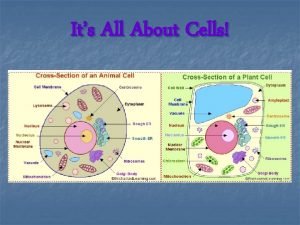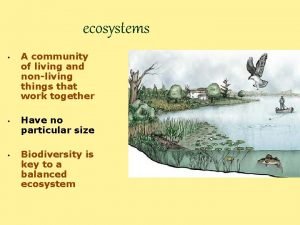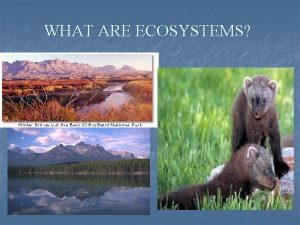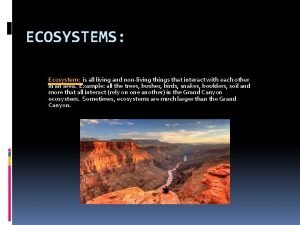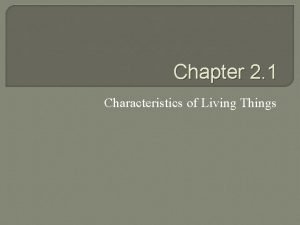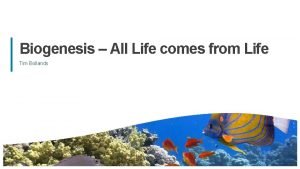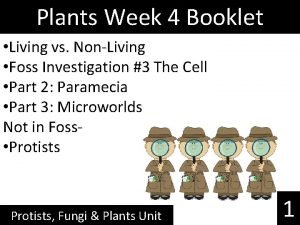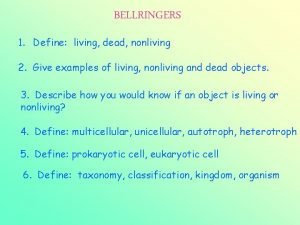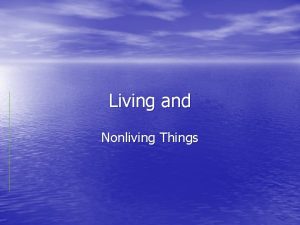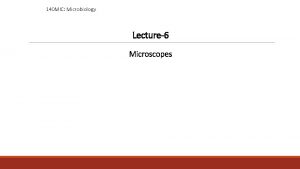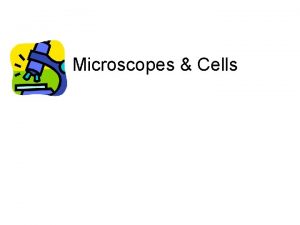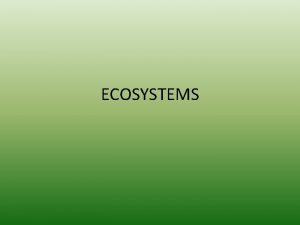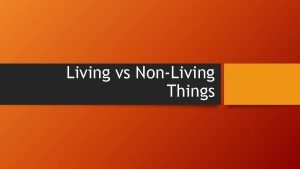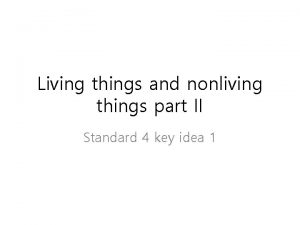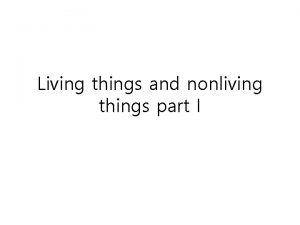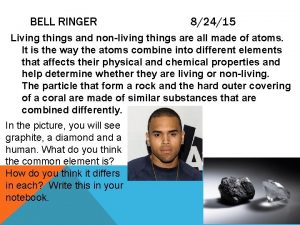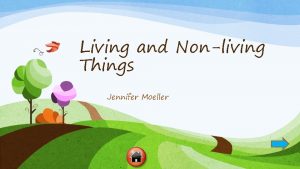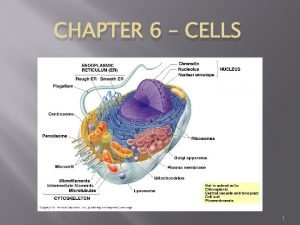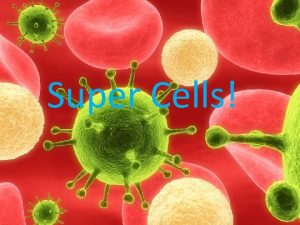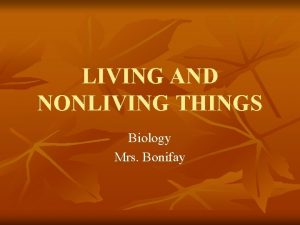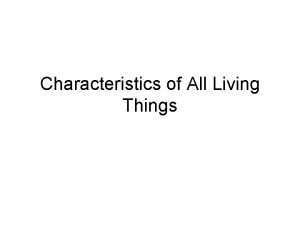LIVING THINGS CELLS AND MICROSCOPES LIVING VS NONLIVING


















- Slides: 18

LIVING THINGS: CELLS AND MICROSCOPES

LIVING VS. NON-LIVING All Living things have the following features: 1. Have one or more cells Cells are the smallest units of organisms that can carry on functions of life 2. Can move From place to place or stuck in one spot but can move around 3. Can respond to Environmental changes Stimulus and Response!! 4. Use Energy How do producers get energy? Consumers? Decomposers? **Respiration – Inside of cells, microscopic food is broken

5. Can adjust to changes in their environment (On the inside!) EX. – When it’s hot, you sweat. When it’s cold, you shiver. 6. Can reproduce Can make more of their species. 7. Can grow and develop Complete and incomplete metamorphosis!! Complete – tadpole to frog to adult Incomplete – baby

8. Can adapt Have the right traits to survive in their environment Ex’s. – Polar bears fur; Whale blubber; Hawk’s talons ***If the “thing” meets all 8 rules, it’s alive!!!!*** How do we know cells exist? ? Microscope and Cell Timeline 1590 Zacharias Janssen puts two magnifying lenses together to make first compound microscope (2 lenses) Early 1600’s Anton Van Leeuwenhoek uses simple microscope (magnifying glass) to see “little animals” in pond water 1665 Robert Hooke slices cork and uses microscope to find tiny boxes and calls them “cells”

1838 Matthias Schleiden uses microscope to look at plants Says they have cells! 1839 Theodor Schwann uses microscope to find animals have cells too! 1854 Rudolph Virchow states new cells come from old ones; The Cell Theory! The Cell Theory 1. All organisms are made up of one or more cells 2. Cells are the basic unit of structure and function in all organisms 3. All cells come from cells that already exist.

Cell Structure Eukaryotic cells have a nucleus (DNA holding organelle) and other membrane bound organelles in it. Prokaryotic cells do not have a nucleus in them. *Plants and animal cells have similarities and differences!*

PARTS OF A CELL 1. Cell membrane: Outer boundary of a cell that lets “stuff” in and out (Factory Walls) 2. Cytoplasm: Gel-like material inside the cell membrane (Factory Floor) 3. Nucleus: Organelle that directs activities inside the cell (Boss’ office) **DNA inside the nucleus The Boss!!** 4. Mitochondria: Organelles where food molecules are broken down for energy (Generator) 5. Ribosomes: Make specific proteins (Toy making machines) 6. Endoplasmic Reticulum (ER): Folded membrane that moves materials around in the cell (Conveyor belts)

7. Golgi Bodies: Stacked structure that packages and secretes proteins (Packaging Department) 8. Lysosomes: Structures inside the cell that destroy and remove wastes (Custodians) 9. Vacuoles/vessicle: Storage inside the cell

**Plants have all these plus 2 more parts!!** A. Chloroplast: organelle in plants where light energy is changed into chemical energy (SUGAR!) during the process of photosynthesis B. Cell Wall: A rigid structure that surrounds the cell membrane of a plant cell to support and protect the cell

HOW DOES “STUFF” GET INTO AND OUT OF THE CELL? ? ? 1. Passive Transport - moving materials in and out of cells without using energy Ex. #1: Diffusion – moving materials from crowded area to a less populated area. When the material is the same amount in and out of the cell, it is called Equilibrium. Ex. #2: Osmosis – Moving WATER in and out of cells

2. Active Transport – moving materials in and out of the cell using energy Cellular Terminology Metabolism – Total of all activities of an organism allowing it to live, grow, and reproduce

WHAT DO CELLS DO? 1. Repair/Replace themselves and other parts of the body 2. Perform specific functions Examples: White blood cell Red blood cell carbon dioxide sperm cell fights “invaders” carries oxygen and reproductive cell 3. Cells make up Tissue, which makes up organs, which make up organ systems, which make up An Organism

FIELD OF VIEW Distance across the diameter of a viewing circle. Once you know the field of view under the chosen objective lens, you can measure the length of your specimens. It’s simple. ! 1. Use a ruler and place it across the diameter of your viewing circle. 2. Line up the left end of your ruler with the left side of the diameter. 3. Count the millimeters or centimeters across. Don’t forget to use mm or cm!!!

• Quiz Time • 1. Give a reason why water is abiotic. • 2. What did Hooke find with his microscope? • 3. Schwann discovery was……. . ? • 4. What’s more powerful, a simple microscope or a compound microscope? • 5. What’s more powerful, an electron microscope or a compound microscope? • 6. What do ribosomes do? • 7. What structure acts like a conveyor belt inside the

• 8. Why are plant cells stronger than our cells? • 9. What structures are the custodians, destroying and removing wastes? • 10. If it weren’t for the ______, the cell would have no energy or power. • 11. What is active transport? • 12. Give one example of passive transport. • 13. Cells _______ organs ____ organism • 14. Why are humans eukaryotic?

Label the Animal Cell! 16 20 17 21 18 22 23 19 24

Label The Plant cell! 31 24 30 25 29 28 26 27

 Whats an energy pyramid
Whats an energy pyramid Are prokaryotic cells living or nonliving
Are prokaryotic cells living or nonliving Ecosystem living and nonliving things
Ecosystem living and nonliving things A community of living and nonliving things
A community of living and nonliving things Non living things in grassland
Non living things in grassland Tropical rainforest living and nonliving things
Tropical rainforest living and nonliving things Living and nonliving characteristics
Living and nonliving characteristics Cells group together to form
Cells group together to form Is tomato living or nonliving
Is tomato living or nonliving Egg living or nonliving
Egg living or nonliving Teori biogenesis
Teori biogenesis Is euglena living or nonliving
Is euglena living or nonliving Is candle a living thing
Is candle a living thing Is sulfolobus living or nonliving
Is sulfolobus living or nonliving Is a starfish living or nonliving
Is a starfish living or nonliving Trees living or nonliving
Trees living or nonliving Nonliving particle that replicates inside a living cell
Nonliving particle that replicates inside a living cell How to remember the 7 life processes
How to remember the 7 life processes The smallest living unit within the human body is
The smallest living unit within the human body is

